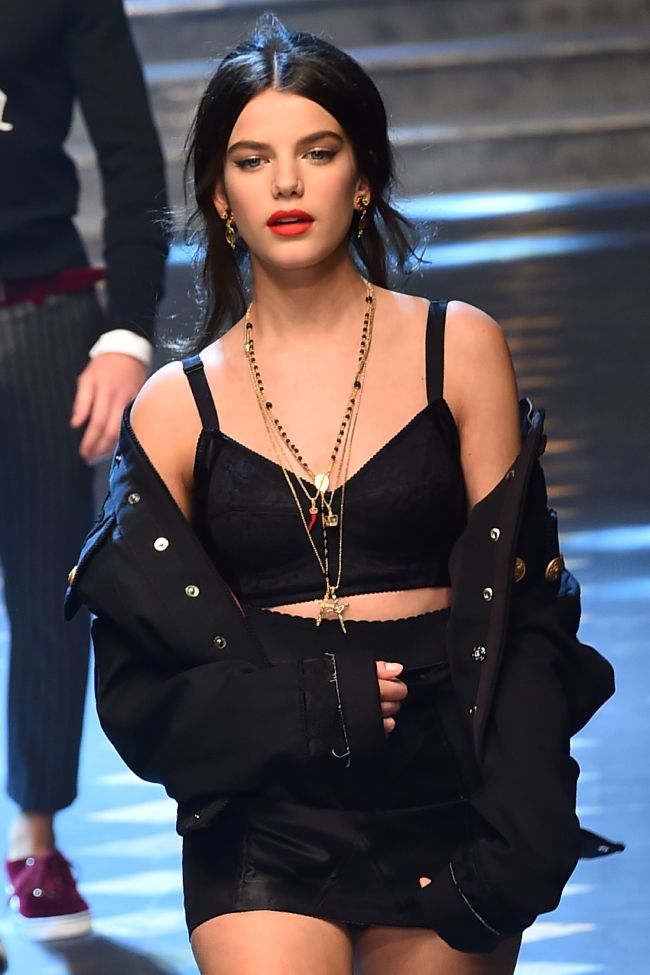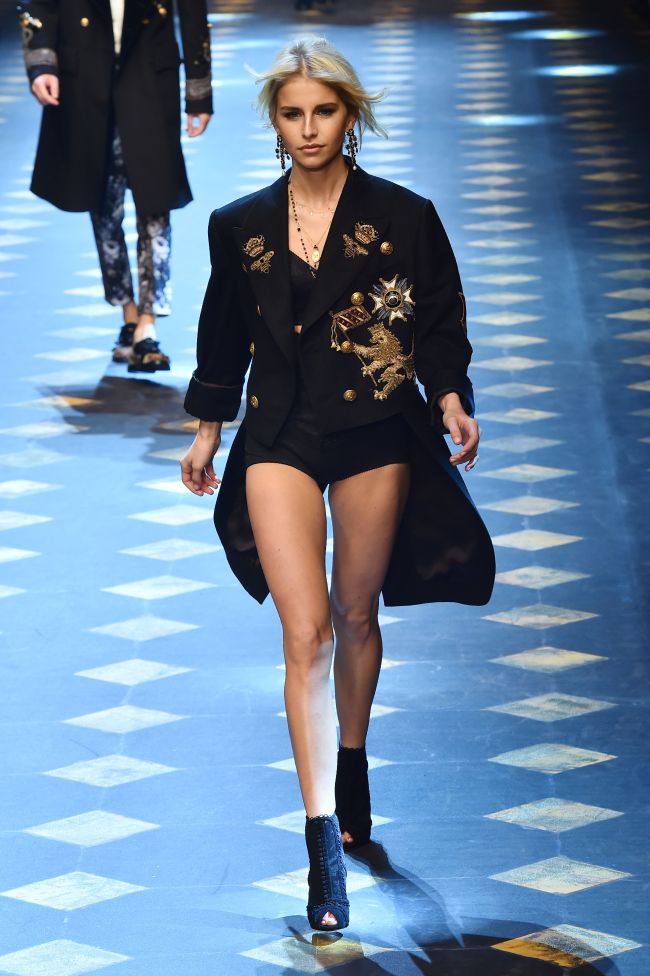Dolce&Gabbana courts millennials, Plein launches activewear
By Yoon Min-sikPublished : Jan. 16, 2017 - 16:15
MILAN (AP) -- If turmoil brings innovation and renovation, Italian menswear is in for a creative burst.
Fashion houses are continuing their reboot of Milan Fashion Week menswear offerings, with notables like Bottega Veneta and Gucci sitting out this round, preferring to combine menswear and womenswear previews next month. That is making room for a plethora of newcomers.
The data indicates that menswear is worth the rethink. Euromonitor market research forecasts that between now and 2020, growth in sales for men’s attire and accessories globally will outpace that of women. Last year alone, Italian menswear produced 9 billion euros ($9.58 billion) in revenue.
Here are some highlights Saturday of menswear previews for next fall and winter on the first day of Milan Fashion Week:
Fashion houses are continuing their reboot of Milan Fashion Week menswear offerings, with notables like Bottega Veneta and Gucci sitting out this round, preferring to combine menswear and womenswear previews next month. That is making room for a plethora of newcomers.
The data indicates that menswear is worth the rethink. Euromonitor market research forecasts that between now and 2020, growth in sales for men’s attire and accessories globally will outpace that of women. Last year alone, Italian menswear produced 9 billion euros ($9.58 billion) in revenue.
Here are some highlights Saturday of menswear previews for next fall and winter on the first day of Milan Fashion Week:

Courting millennials
Dolce&Gabbana have one-upped themselves, moving the young millennial crowd that has populated their front row in recent seasons onto the runway.
Pop star Austin Mahone, dapper in a tux with tapered legs, set the mood, dancing up and down the runway throughout the show, making the moves on the ladies, who included Sylvester Stallone’s three daughters.
Dolce&Gabbana’s show was titled “The New Princes” and it’s clear that they are catering to a young, selfie-savvy generation bred on social media. In an ultimate branding move, the designing pair created a pair of faceQ app-like images of themselves on jackets and sweaters.
Alongside the brand’s trademark tailored suits, the new collection includes zany plush animal head hoods or backpacks, and Rasta knit hats or crowns over baseball caps, fun-loving Harajuku touches for a generation that prizes its juvenile side. Jeans and jackets were covered with appliques, with royal motifs from crowns to hearts emerging as decorative emojis.
The collection was a fast and furious display of graphic prowess with humanized animal motifs alongside the brand’s typical religious imagery, a display as breathless as the new generation of star power on the runway.

Cross cultural
The new Versace man is both a traveler who means business and a sportsman who knows how to relax.
His suits fit close to the body, paired with dark glasses and two-toned sneakers, topped with double-breasted overcoats, knitted blanket jackets or belted trenches. After hours, he relaxes with hoodies under bomber jackets, worn with the day’s trousers or athletic pants. And on the weekend, he hits the outdoors in plaid shirts and shearling coats.
Models crisscrossed the runway beneath arched gates, suggesting a Middle Eastern market. The exotic vibe also was reflected in ethnic patterns that cut diagonally along jackets, or were put tile-like on bombers.
Versace’s neoclassic Greek patterns were replaced this round with photographic prints of classical sculptures.
“This is a collection about the different tribes of Versace men,” Donatella Versace wrote in show notes, “and the powerful positivity that can happen when men from different places, different cultures join together.”
Rumpled iconoclast
Marni has taken a rumpled, colorful turn. The new Marni man, as imagined by creative director Francesco Risso in his debut season, is something of a light-hearted vagabond.
The brand’s heritage fur appears in hats that have the appearance of colorful wigs, as square tufts on jacket sleeves, wisps on collars and finally, in their full glory, as fluffy overcoats.
There is a geometry to the looks, reflected in the square cuts of the suits and the plaid and checks of the prints. Woolen suits have a rumbled, train-hopping feel. Tops project optical illusions, created from mismatched patches of striped fabric.
Sweaters feature naive 1970s graphics, tucked into high-waist, big-fitting corduroy trousers. Quilted trousers in pajama prints are paired with bomber jackets.
The effect is that of an iconoclast, which seems influenced in some measure by Risso’s last employer, Prada. The designer, who studied in Florence, New York and London, took over from the brand’s creator, Consuelo Castiglioni, who stepped down last October, citing personal reasons.
Classics reinterpreted
Giorgio Armani has reinterpreted classics through the decades with a modern edge for his youthful Emporio Armani line.
Armani is hewing to the traditional menswear and womenswear calendars, but blurring the line on the runway.
Many of the looks were feminized, like flowing knitwear or curved hemlines on short jackets. Trousers tended to be ample and pleated, and Armani employed luxurious fabrics like velvets for men and lots of fur, both as trim and full fur coats.
Double-breasted suits with soft hemlines and loose trousers recalled a 1940s cool, while fur collars on overcoats harkened to a 1970s mod.
Armani mixed geode-like patterns with plaids, sticking with gray scale to black for a contemporary urban feel. Thick, furry neck warmers framed the face, while molded brim hats topped the sophisticated silhouette.
Hair was slicked back and footwear had thick traction soles. Bags included big pockets on cross-body halters. The color palette was classic: gray, black, tan and olive green.
Monumental looks
Alessandro Sartori made his debut Friday evening as the Creative Director of Ermenegildo Zegna in a monumental style, sending his creations down a runway flanked by Anselm Kiefer’s towering installation of The Seven Heavenly Palaces at Pirelli‘s cavernous Hangar Bicocca.
The looks exuded relaxed sophistication, as tailoring altered sportswear, and vice versa. Or, as the brand said in its press notes, Sarotori’s “new aesthetic ... evolves and breaks codes, relying on intense textures and keen constructions that define new functions.”
Elasticized cuffs on trousers and gathers on jackets gave suits an active feel that was completed with sneakers. Felted cashmere suits had the simplicity of jersey, with quilted arms in contrast colors to create a vest effect over kimono neckline shirts.
Nubby Casentino felt from Tuscany was created from cashmere and alpaca, suggesting ease but underlining elegance in loose-fitting suits. Cozy accents included high necks, big gloves and droopy caps.
Colors tended toward gray, tan and black neutrals while turquoise and white popped up on leather jackets and large knits.
Luxury activewear
Phillip Plein has found what he says is an untapped niche: luxury activewear.
On the first day of Milan Fashion Week, the German designer debuted his new Plein Sport line, which he only first envisioned last June after discovering that the biggest grossing textile companies weren’t traditional fashion houses, but Nike and Adidas.
“Active sportswear is one of the biggest segments, but we don’t have even one luxury alternative,” Plein told the assembled fashion crowd. Until now.
Gymansts flipped in Plein Sport pants. Muscle-bound boxers shimmied in shorts. Skiers donned silvery parkas with black face masks. Female runners were clad in floral running tights and tops. A kickboxer wore a midriff-baring neoprene top over tights. And dancers splashed in a pool of shallow water to the rhythmic beat of drums.
While there was a collective groan of disappointment from the crowd when Plein, the Milan fashion world’s premier showman, announced last season he would be moving to New York with his main line, the designer showed he has plenty of party left for Milan.








![[KH Explains] How should Korea adjust its trade defenses against Chinese EVs?](http://res.heraldm.com/phpwas/restmb_idxmake.php?idx=644&simg=/content/image/2024/04/15/20240415050562_0.jpg&u=20240415144419)











![[Today’s K-pop] Stray Kids to return soon: report](http://res.heraldm.com/phpwas/restmb_idxmake.php?idx=642&simg=/content/image/2024/04/16/20240416050713_0.jpg&u=)